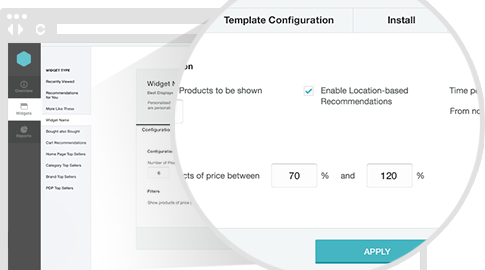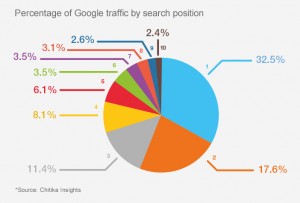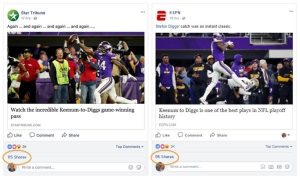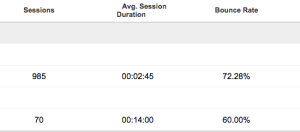
We keep hearing about all the different ways brands can work more efficiently to convert visitors to their website. Conversion optimization advice typically revolves around website design, on-page and off-page SEO ranking signals, content marketing, social media marketing, and so on.
But what about that gem of a marketing tool called personalization? What happens when brands spend some time treating their target audiences like people instead of treating them as numbers in an excel sheet? This does not even have to be on your website alone. What happens when you offer some personal TLC via your brick and mortar store, your email campaign or even your mobile ads? Good things, I assure you.
Read on for insights into how personalization can be your secret weapon in the race for conversion optimization.
1. Personalized Web Content Based On Historical Data
Equality is a good ideal to cherish, but it’s definitely not one you want to adopt when it comes to serving up content to website users. When your website speaks the same language to a mother of three kids as it does to a teenage girl, you’re eventually not going to convince either of them to buy from you. In fact, 74 percent of users get frustrated when website content does not match their interests.
In our era of big data and efficient data analytics capabilities, it is unforgivable that marketers do not use website data to develop content that speaks to each user in their own language. With the availability of superb data analytics tools that can cut through dense data sets and equally effective personalization tools to translate those data insights into real action, providing an individualized user experience to your visitors is not as scary as it once seemed.
Personalization can occur at two fundamentally different levels: One, it could mean displaying personalized product recommendations on e-commerce sites based on data from previous browsing sessions. Amazon does this brilliantly right from the get-go. Apart from personalized content on the homepage, the company also offers products based on your current browsing session, often leading to cross-sells and upsells.

If you’re an e-commerce retailer, you can do the same with a product recommendation solution such as Unbxd. Apart from the regular top selling, most viewed and also bought products, you can create precise merchandizing rules to show location, brand and price-based recommendations to shoppers.

Then there are personalized landing pages depending on the source from which the user has arrived. You can mine location and social network profile data to target visitors with a message highly relevant at the time. A tool like Personyze will allow you to create dynamically personalized, granular landing pages with relevant content, images and calls to action for every visitor.
For example, say I Google a variant of the term “tort law” and arrive on a lawyer’s site. Instead of the regular home page, which looks like this:

I could be offered a customized page, which looks like this:

Service firms can emphasize their expertise in the specific field that the visitor is looking for and convey a feeling that they are in the right place.
2. Personalized Email Marketing
Using a personalized subject line is like greeting an acquaintance by their name instead of a plain nod. It tells that acquaintance they matter to you and you care enough to remember their name and identify them personally by it. And it’s not just me saying it. The impact of personalization shows in the conversion rates personalized emails get as compared to those not personalized.
According to a study by Experian, personalized subject lines get six times higher open rates than those not personalized. Among the hundreds of emails one receives every day, few get opened, let alone read or acted upon.
To cut through the cacophony of marketing emails in your users’ inbox, try a little personalization. Craft subject lines that address the user by name and draw their attention to the contents of your email. Mind you, keep the subject lines under 65 characters. With more than half of all emails now being opened on smartphones, you don’t want your subject lines to be only half seen.
Personalization impacts not just open rates, but also transaction rates. Among triggered emails, personalization led to double the transaction rates compared to those of triggered emails not personalized.
Remember, personalization in your email marketing does not end with subject lines. Offering personalized content to users based on data you collect takes your marketing efforts up a notch.
It also makes the experience more relevant and valuable to the user. British Gas found a 39 percent growth in click rates, a 58 percent drop in unsubscribe rates and a 52 percent jump in open rates once it implemented personalized content (check out the graphs!) inside each of their user emails.

3. Promotions Based On Live Data
This is the ultimate test of personalization. Unlike personalization based on past data, gathered during previous sessions, personalization using live data is like a conversation between the brand and its user in real time. This could be targeted offers based on current browsing patterns, personalized content redirecting users to different pages based on specific actions taken in the current session or even limited period geo-specific offers based on the current location of the user.
A study by Infosys shows 67 percent of users cite personalized coupons based on their browsing activities as something they can use immediately. The Location Powered Mobile Advertising Report shows location based ads on mobile phones received more than double the CTRs than plain-Jane ads.
Whether you put up QR codes in your store with personalized promotions for your users or invest in building advertising campaigns that treat different segments of users to completely different experiences, it’s time to kick start this basic level of personalization right away.
Why? Because software company Panaya saw a 113 percent jump in content consumption by simply altering the landing pages for different user segments.

Panaya’s advertising campaign actively identified users who were SAP customers and distinguished them from Oracle customers. Each segment was served a unique landing page with completely different copy, visual content and CTAs.
In Conclusion
As technology brings brands closer to their users, the fact that they’re being watched is not lost on consumers. A whopping 84 percent of consumers are well aware their digital lives are being tracked by marketers and corporations. The surprising nugget here is that at least 65 percent of these consumers have no problems sharing personal data with brands as long as it eventually benefits them.
The writing on the wall is amply clear—users don’t mind sharing data as long as it is useful to them. Personalization has been shown to offer definite results. Brands around the world, including your competitors, are using consumer data to personalize their marketing towards them. Are you?
(206)
Report Post




